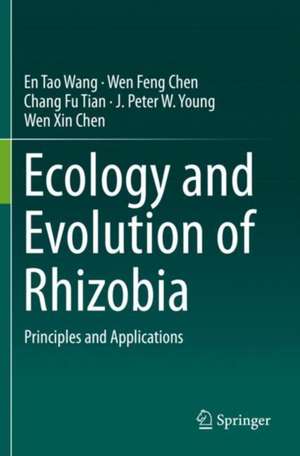Ecology and Evolution of Rhizobia: Principles and Applications
Autor En Tao Wang, Chang Fu Tian, Wen Feng Chen, J. Peter W. Young, Wen Xin Chenen Limba Engleză Paperback – 28 noi 2020
| Toate formatele și edițiile | Preț | Express |
|---|---|---|
| Paperback (1) | 783.02 lei 39-44 zile | |
| Springer Nature Singapore – 28 noi 2020 | 783.02 lei 39-44 zile | |
| Hardback (1) | 793.56 lei 39-44 zile | |
| Springer Nature Singapore – 28 noi 2019 | 793.56 lei 39-44 zile |
Preț: 783.02 lei
Preț vechi: 1030.28 lei
-24% Nou
Puncte Express: 1175
Preț estimativ în valută:
149.84€ • 160.22$ • 124.93£
149.84€ • 160.22$ • 124.93£
Carte tipărită la comandă
Livrare economică 14-19 aprilie
Preluare comenzi: 021 569.72.76
Specificații
ISBN-13: 9789813295575
ISBN-10: 9813295570
Pagini: 273
Ilustrații: XIII, 273 p. 41 illus., 26 illus. in color.
Dimensiuni: 155 x 235 mm
Ediția:1st ed. 2019
Editura: Springer Nature Singapore
Colecția Springer
Locul publicării:Singapore, Singapore
ISBN-10: 9813295570
Pagini: 273
Ilustrații: XIII, 273 p. 41 illus., 26 illus. in color.
Dimensiuni: 155 x 235 mm
Ediția:1st ed. 2019
Editura: Springer Nature Singapore
Colecția Springer
Locul publicării:Singapore, Singapore
Cuprins
Preface.- Chapter 1. Symbiosis between rhizobia and legumes.- Chapter 2. History of rhizobial taxonomy.- Chapter 3. Current Systematics of rhizobia.- Chapter 4. Genomics and evolution of rhizobia.- Chapter 5. Symbiosis genes: diversity and organization.- Chapter 6. Evolution of symbiosis genes: Vertical and horizontal gene transfer.- Chapter 7. Diversity of interactions between rhizobia and legumes.- Chapter 8. Geographical distribution of rhizobia.- Chapter 9. Environmental determinants of biogeography of rhizobia.- Chapter 10. Effects of host plants on biogeography of rhizobia.- Chapter 11. Rhizobial genomics and biogeography.- Chapter 12. Current status of rhizobial inoculants.- Chapter 13. Screening for effective rhizobia.- Chapter 14. Usage of rhizobial inoculants in agriculture.- Chapter 15. Rhizobial activity beyond nitrogen fixation.- Chapter 16. Working on the taxonomy, biodiversity, ecology and evolution of rhizobia.- Index.- Acknowledgments.
Notă biografică
Dr. Wen Xin Chen, Dr. Wen Feng Chen and Dr. Chang Fu Tian currently work at the College of Biological Sciences and Rhizobium Research Center, China Agricultural University. Dr. Wen Xin Chen was elected into the Chinese Academy of Sciences in 2001. Dr. Wen Xin Chen and Dr. Chang Fu Tian are members of the ICSP Subcommittee on the Taxonomy of Rhizobia and Agrobacteria.
Dr. En Tao Wang works at the Departamento de Microbiología, Escuela Nacional de Ciencias Biológicas, Instituto Politécnico Nacional, Mexico.
Dr. J Peter W Young is an Emeritus Professor of Molecular Ecology at the University of York. He is the Chairman of the ICSP Subcommittee on the Taxonomy of Rhizobia and Agrobacteria.
Dr. En Tao Wang works at the Departamento de Microbiología, Escuela Nacional de Ciencias Biológicas, Instituto Politécnico Nacional, Mexico.
Dr. J Peter W Young is an Emeritus Professor of Molecular Ecology at the University of York. He is the Chairman of the ICSP Subcommittee on the Taxonomy of Rhizobia and Agrobacteria.
Textul de pe ultima copertă
This book reviews the history and development of rhizobial ecology (diversity, function and interactions with the biotic and abiotic environments), evolution (genome diversification, systematics of symbiotic genes) and application. Further, it describes the new concept of rhizobia, the latest systematic methods, biogeographic study methods, and genomic studies to identify the interactions between rhizobia, legumes and environments. To enable readers to gain a comprehensive understanding of rhizobial biogeography, the book provides effective protocols for the selection and application of high-efficiency rhizobial inoculants. In addition, it presents standard and modern methods used in studies on rhizobial ecology and evolution in dedicated appendices, making it a unique and valuable handbook for researchers.
Caracteristici
Reviews the background of rhizobial ecology and evolution Presents effective protocols used in studies on rhizobial ecology and evolution Provides a valuable one-stop resource for those new to the field of rhizobial diversity and established research groups alike
